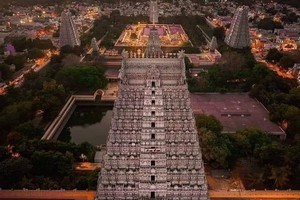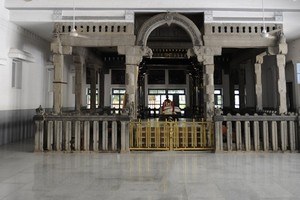Parvathamalai, Tiruvannamalai - Timings, Festivals, History, Darshan, Pooja Timings
Photo Credit: Flickr
 Distance (From Tiruvannamalai): 36 Kms
Distance (From Tiruvannamalai): 36 Kms
 Trip Duration (Including Travel): 3-4 Hours
Trip Duration (Including Travel): 3-4 Hours
 Transportation Options: Bus / Cab
Transportation Options: Bus / Cab
 Travel Tips: None
Travel Tips: None
About Parvathamalai
At a distance of 36 km from Thiruvannamalai, Parvathamalai is a mystical mountain situated at Thenmathimangalam village in the Tiruvannamalai District of Tamilnadu. Located in the Eastern Ghats of Tamil Nadu, it is one of the top pilgrimage sites in Tamil Nadu, and among the best places to visit near Madurai. The name Parvathamalai means Mountain of the Goddess in Tamil, highlighting its connection to Hindu mythology and spirituality. At the peak of Parvathamalai stands the Parvatha Malaiyappan Temple, dedicated to Lord Mallikarjuna Swamy, an incarnation of Lord Shiva. The temple is not only a spiritual hub but also a popular trekking destination.
History & Mythology of Parvathamalai
Situated atop a hill that rises 4,500 feet, the Parvathamalai Temple was established approximately 2,000 years ago by the Siddhars, who came to meditate and attain enlightenment. It is thought that this hill is a remnant of the Sanjeevani Mountain. According to legend, when Lord Hanuman transported the Sanjeevani Paravat to revive Lakshmana during the conflict with Ravana in the Ramayana, a portion of the mountain broke off. The mountain that Hanuman carried is reputed to be abundant in herbs capable of curing even the most severe ailments. The atmosphere in this region is believed to be healthful, as it is infused with the essence of these herbs, promoting both mental and physical well-being. Parvathamalai is regarded as a site of concealed supreme powers where extraordinary occurrences take place. Both locals and pilgrims hold the belief that Siddhars inhabit the area surrounding the hill, engaging in meditation and occasionally bestowing darshan upon fortunate visitors.
Architecture of Parvathamalai
Representing the Dravidian style of architecture, the sanctum of the temple houses a Shiva Linga, who is worshipped as Lord Mallikarjuna, and his consort goddess Parvathi as Parvathammal. It is believed that the deity grants the wishes of devotees and aids in the pursuit of greater wisdom and ultimately, salvation. Notably, the temple lacks a door and remains perpetually accessible, symbolizing the divine essence of the deity.
To access the temple, visitors must embark on a tough trek to the summit of the hill. Along the way, there are shrines dedicated to Lord Hanuman, Vinayagar, Pachai Amman, as well as 7 Muniswarar and Vana Durga goddesses. At the base of the hill, there is a temple devoted to Lord Vinayagar. Prior to reaching the hilltop, there is a dilapidated fort constructed by King Nannan around 300 AD., who ruled over Cheyar and served as the chieftain of Chengam.
In this sacred space, no priest conducts the rituals, allowing devotees the freedom to worship independently and make offerings to the Lord. It is advisable to bring necessary supplies, as there are no shops available once the hill is reached.
Festivals of Parvathamalai Temple
The Full Moon and New Moon Days are of great importance at Parvathamalai. Devotees hold the belief that engaging in meditation and conducting poojas on these occasions yields significant blessings. During these nights, special poojas, abhishekams, and bhajans are organized. Among the various festivals celebrated at Parvathamalai, Maha Shivaratri stands out as one of the most significant, featuring all-night vigils, the chanting of Shiva mantras, and unique abhishekam ceremonies dedicated to the deity.
Dress Code & Other Restrictions of Parvathamalai Temple
There is no specific dress code for Parvathamalai Temple in Tamil Nadu, India. Nevertheless, it is advisable to wear comfortable dress and footwear and to carry sufficient water during your visit to the temple.
The Parvathamalai Temple welcomes visitors from all backgrounds, regardless of religion, caste, or creed. However, it is important to note that the Parvathamalai Trek presents significant challenges and may not be suitable for inexperienced trekkers or elderly individuals suffering from knee issues.
Parvathamalai Temple Timings
Monday: 24 Hours
Tuesday: 24 Hours
Wednesday: 24 Hours
Thursday: 24 Hours
Friday: 24 Hours
Saturday: 24 Hours
Sunday: 24 Hours
Parvathamalai Temple Entry Fee
Entry is Free
Parking Fee is Rs. 10
Best Time to Visit Parvathamalai
The optimal period for undertaking the Parvathamalai Trek is between September and February. The trail tends to become slippery and more difficult to navigate during the monsoon season, which complicates the trekking experience. In the summer months, the weather is excessively hot, with temperatures potentially exceeding 40°C. This can result in a rapid onset of dehydration, thus it is advisable to refrain from visiting during this time.
How to Reach Parvathamalai
The nearest airport to Parvathamalai is Chennai International Airport, situated approximately 175 kilometers away, offering regular flights from numerous cities throughout India. The closest railway stations are located in Polur and Tiruvannamalai, approximately 22 kilometers and 33 kilometers from Parvathamalai, respectively, both providing good connectivity to Chennai, Vellore, Puducherry, and Bangalore. From there, one needs to take a bus or hire a cab to reach the base village.
There are two routes leading to the temple at the summit, which converge halfway up: the Kadaladi route and the Thenmadimangalam route. The 6-kilometer Thenmadimangalam route is frequently chosen by pilgrims, taking approximately three hours to reach the summit, while the Kadaladi route is favored by trekkers due to its greater difficulty.
The trek is renowned for its rugged and demanding terrain, providing an exhilarating experience for trekkers. Participants must navigate rocky paths and ascend steep sections to reach the summit. A portion of the hill features a pathway equipped with rods, known as Kadaparai, which assists climbers in traversing the steep landscape, thus earning the designation Kadaparai Padai. Trekkers are also treated to expansive and tranquil views of the Eastern Ghats as they ascend. Additionally, free meals and clean drinking water are available at any time of day at the Veerabhadrar Temple and at the summit.













